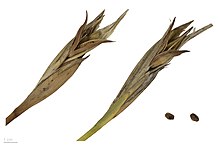Iris graminea
It is a rhizomatous perennial, with purple or violet blue flowers almost hidden by narrow, grass-like leaves, and a plum scented fragrance.
This species naturally occurs in the southern half of Europe, from Spain and France in the West to Russia and the Caucasus in the East.
[13][14] The centre of the blade has a pale yellow or white central area,[15] which is veined with violet, purple, or blue.
[17] As most irises are diploid, having two sets of chromosomes, this can be used to identify hybrids and classification of groupings.
[18] The Latin specific epithet graminea refers to grassy due to the grass-like leaves.
[23] It is usually found growing in scrubland, grasslands, meadows, open woods, and in rocky or gravelly soils of the mountains.
[24] I. graminea is considered an endangered species in the Czech Republic and in Slovakia,[25] vulnerable in Hungary,[23] and rare within Saxony.
[30] It can also be susceptible to damage by insects such as; flies, weevils, moths, thrips, slugs, snails, aphids, and nematodes.
[28] It was first grown in Cambridge Botanic Garden in 1733, where it was labelled as narrow leafed plum scent iris.
Large clumps of mature plants can be lifted between mid-summer to early autumn, then divided before being replanted.
[28] Seeds are collected from the pods after flowering, whichare then sown in containers on a cold frame between September and May.

